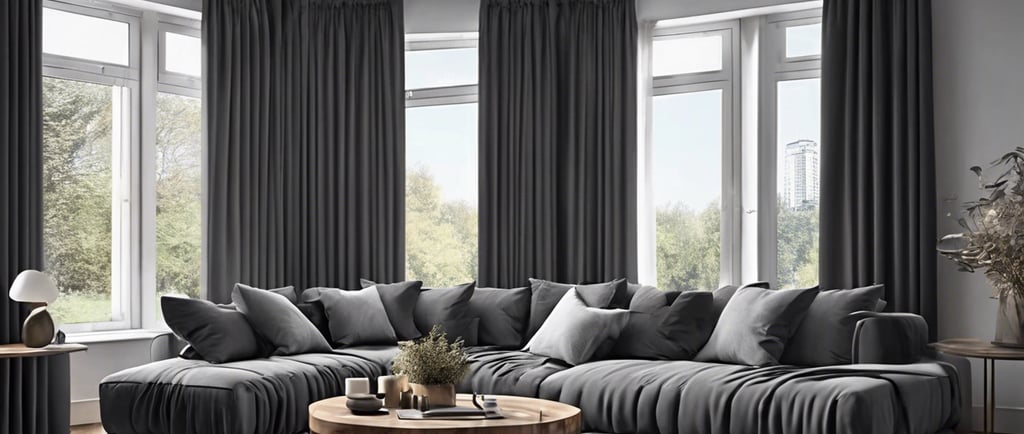Global Inflation and the Price of Curtains: Navigating Rising Costs in the Home Textile Market
11/30/20244 min read


Understanding Global Inflation
Global inflation refers to the general increase in prices across various economies, affecting goods and services worldwide. This phenomenon is primarily driven by a combination of factors, including increased production costs, supply chain disruptions, and shifts in consumer demand. As different regions experience unique economic conditions, the impact of inflation can vary significantly from one area to another.
One critical cause of global inflation stems from rising production costs. Prices for raw materials, labor, and energy can fluctuate due to economic policies, environmental regulations, and geopolitical tensions. For instance, a sudden increase in oil prices can lead to higher transportation and manufacturing costs, which contribute to a broader rise in consumer prices. Additionally, supply chain disruptions, exacerbated by natural disasters or global events such as pandemics, can hinder the availability of products, further driving up prices.
Changes in consumer demand also play a pivotal role in inflation dynamics. When demand for goods and services outpaces supply, businesses may raise prices to align with the market conditions. This situation can result from economic recovery phases where consumer confidence boosts spending, or from shifts in preferences due to life changes, such as more people working from home. The distinctly varying inflation rates across regions can be attributed to differing economic recovery rates and local market conditions.
In the context of the home textile market, including the price of curtains, the broad trends of global inflation must be understood alongside regional economic conditions. Variations in inflation rates can significantly influence the operational costs for manufacturers, supply chain logistics, and ultimately the price points consumers see in stores. As such, tracking these inflationary trends is essential for stakeholders within the home textile industry, making them more adept at navigating the complex market landscape.
Impact of Rising Costs on Home Textiles
In recent years, the home textile industry, particularly in the sector of curtains, has faced significant challenges due to rising global costs. These escalating expenses are largely a result of fluctuations in material prices, manufacturing processes, and increased freight charges. Key components such as cotton, polyester, and other fabric types have seen price surges, which have directly influenced the cost structure for curtain manufacturers.
Labor costs have also played a critical role in the pricing dynamics of home textiles. As wages rise in key manufacturing regions, companies are compelled to adjust their pricing strategies to maintain profitability. This labor cost inflation, coupled with the increasing prices of raw materials, exerts upward pressure on retail prices for curtains. Consequently, consumers are witnessing higher costs for these essential home products, impacting their purchasing decisions.
The consequences of these rising costs are prompting various responses from companies in the home textile market. Some manufacturers are opting to pass the increased costs directly to consumers through price hikes. Others are exploring product substitutions—switching to less expensive materials or using alternative manufacturing processes to keep prices competitive. Moreover, some companies are looking beyond their traditional suppliers, seeking out alternative sourcing opportunities to mitigate the impact of rising costs. This strategic shift in sourcing not only affects pricing but also influences the quality and variety of products available to consumers.
As the situation continues to evolve, the interplay between rising costs and market dynamics remains complex, impacting both manufacturers and consumers alike. The approach taken by companies in response to these challenges will shape the home textile market landscape in the coming years, ultimately determining consumer accessibility to curtain products.
Consumer Behavior Amidst Price Increases
As global inflation continues to influence the economy, consumers are becoming increasingly conscious of their spending habits, particularly in the home textile market. The rising costs of curtains and other textile products have prompted many shoppers to reevaluate their purchasing decisions. One notable reaction is the shift towards more affordable alternatives. Rather than investing in premium curtain brands, consumers are exploring budget-friendly options that still provide suitable aesthetic and functional attributes. This transition is indicative of a broader trend where affordability takes precedence over brand loyalty during such economically challenging periods.
Furthermore, as consumers prioritize their spending, discretionary purchases, such as luxury curtains, may take a backseat to essential items. This behavioral shift often leads individuals to allocate their budgets more strategically, opting to invest in necessities like food and household essentials over home decor. Consequently, businesses in the textile sector may need to adjust their inventories and offerings to align with shifting consumer priorities, potentially introducing a range of economical curtain options to cater to the changing demographics of shoppers.
Amidst price hikes, there has also been an observable trend towards do-it-yourself (DIY) projects and upcycling. Consumers are increasingly drawn to creative solutions that enable them to enhance their living spaces without incurring substantial costs. DIY curtain-making, for instance, allows shoppers to express their personal style while minimizing expenses. Upcycling old textiles into new window treatments not only promotes sustainability but also offers an innovative approach to home decor in a time of inflated prices.
In response to these evolving consumer behaviors, marketing strategies within the textile industry are shifting. Companies are emphasizing value, practicality, and sustainability in their campaigns, aiming to resonate with cost-conscious consumers. By highlighting the affordability and usability of their products, businesses can maintain relevance in a marketplace where consumers are seeking solutions to navigate financial constraints.
Strategies to Navigate the Rising Costs
As consumers and businesses alike face the impact of rising inflation on home textiles, it is crucial to adopt effective strategies to mitigate these increasing costs. For consumers, budgeting for home textile purchases can be an essential first step. Creating a clear financial plan allows individuals to prioritize their needs, ensuring that they allocate funds appropriately for essential items like curtains while avoiding impulsive purchases.
Additionally, seeking out sales and promotions can significantly ease the burden of rising prices. Many retailers offer seasonal sales or discounts on overstock items. Keeping an eye on these opportunities can enable consumers to acquire high-quality products without straining their budgets. Online shopping platforms frequently highlight special offers, making it easier for consumers to compare prices and find the best deals.
Choosing quality over quantity is equally important. While it may be tempting to purchase several lower-priced items, investing in durable, high-quality curtains can ultimately be more economical. Quality textiles typically last longer and can help maintain energy efficiency in homes, offering additional value amidst rising costs.
For businesses, enhancing supply chain efficiency is a pivotal measure in navigating the current economic landscape. Streamlining operations can reduce unnecessary expenses, allowing companies to provide competitive pricing despite inflationary pressures. Maintaining strong supplier relationships also plays a critical role; having reliable partners can lead to advantageous negotiations and pricing strategies.
Furthermore, businesses should consider innovative product offerings that differentiate them from competitors. Diversifying into sustainable or locally sourced fabrics can appeal to conscientious consumers while possibly reducing shipping costs. Flexibility and adaptability are essential traits for businesses aiming to thrive in this ever-evolving market environment.
Curtains&Fabrics
Design,production,sales,service in curtain fabrics&curtians.
Quality
Products
sales01@anytextile.com
+8615968501933
© 2024. SHAOXING LEYAO IMPORT AND EXPORT CO.LTD All rights reserved.
